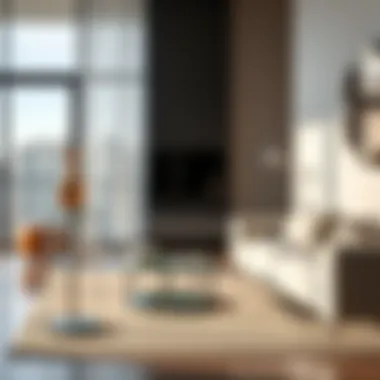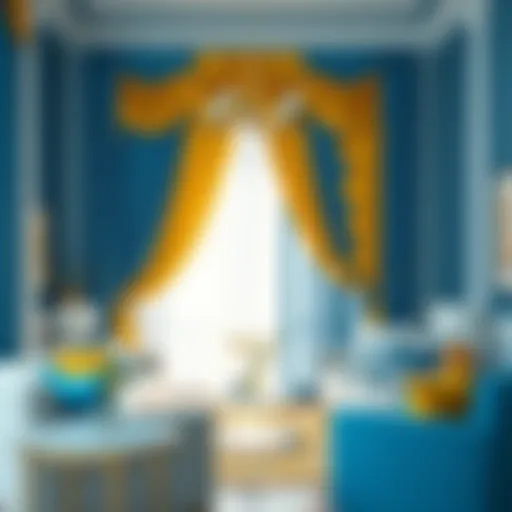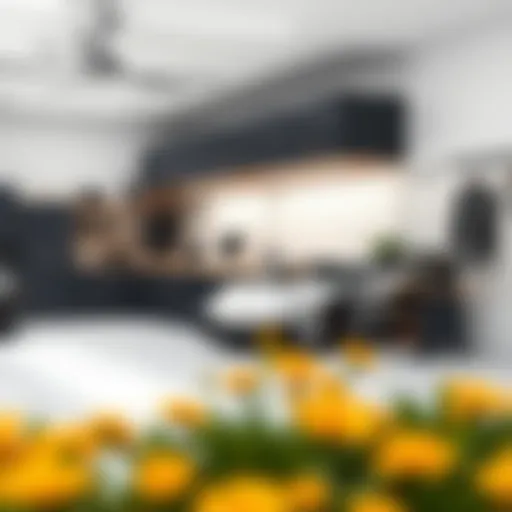Exploring the Multifunctional Role of Tall Glass Stands


Intro
In the realm of contemporary design, tall glass stands have emerged as a pivotal player. These elegant structures are not just functional but also offer a stunning visual appeal that can elevate any space. Whether positioned in a cozy living room or a bustling retail environment, the versatility of tall glass stands provides opportunities for both homeowners and designers to express their individual style while meeting practical needs.
There’s a myriad of uses for these glass beauties. They often serve as display cases for cherished collectibles or ambient lighting features that enhance the overall ambiance. What is more, their transparent nature allows light to travel through, creating an illusion of space even in smaller areas. This adaptability makes tall glass stands a favorite among interior designers and furniture enthusiasts alike. But how do they fit into the bigger picture of modern interiors? This exploration will reveal not just their aesthetic facets, but also the intrinsic qualities that make them an asset in various settings.
Furniture Styles and Trends
Modern vs. Traditional: Understanding the Aesthetics
When discussing furniture, it's essential to recognize the stark contrast between modern and traditional styles. Tall glass stands fit seamlessly into both, albeit with different roles to play. In modern aesthetics, they often feature clean lines, minimalistic designs, and a focus on functionality. For example, a tall glass stand can serve as a sleek means of showcasing contemporary art pieces, drawing the eye without overwhelming the surrounding decor.
On the flip side, traditional settings might incorporate these stands with ornate frames or combined materials like wood and brass, where the glass acts as a focal point contrasting with intricate designs. This harmonious blend of modern and traditional not only caters to design preferences but also emphasizes the adaptability of tall glass stands across various interior themes.
Color and Material Trends: What's In and What's Out
In recent years, color trends have evolved drastically. Bold, saturated hues are all the rage, but when it comes to tall glass stands, natural materials often take center stage. Stands framed with brass or aged bronze within sleek glass constructions have become increasingly popular, marrying old-world charm with modern sensibilities.
- What's in:
- What's out:
- Metallic finishes
- Textured glass designs
- Earthy tones like terracotta or deep greens in nearby decor
- Minimalism with the focus on shape and function
- Overly ornate detailing that distracts from the glass itself
- Bright plastic colors that cheapen the aesthetic
"A tall glass stand can be a silent partner in the dance of room decor, offering balance, elegance, and a hint of charm without taking the spotlight."
Furniture Care and Maintenance
A piece of furniture, no matter how exquisite, demands care to maintain its allure. This holds true for tall glass stands as well. Knowing a few key maintenance tips can ensure that these beautiful structures remain looking new for years to come.
Tips for Prolonging the Life of Your Furniture
- Regular Cleaning: Use a soft, lint-free cloth for the glass surface. Avoid anything abrasive that might scratch.
- Avoid Direct Sunlight: Excessive sunlight can lead to fading or discoloration of any decorative items on the stand.
- Check Stability: Periodically ensure that the stands are stable and not wobbling, as even small shifts can lead to accidents in busy spaces.
- Guard Against Spills: Especially in dining settings, be mindful of beverages that might spill onto the glass; a coasters should always be used.
DIY Repair Hacks for Common Furniture Issues
Sometimes, even the most cherished pieces might acquire minor scratches or chips. Here are some simple tricks to mend them:
- Scratch Fix: For small scratches on glass, use a mixture of baking soda and water to create a paste; gently apply to scratches, then wipe away with a clean cloth.
- Chip Repair: Use clear nail polish to fill in minor chips; once dry, gently buff with a soft cloth to match the surrounding glass.
Understanding the nuances of style trends and maintenance will ensure that tall glass stands serve their purpose both effectively and beautifully in modern interiors. This guide aims to not only inform but also inspire readers to integrate these stunning pieces into their own spaces, enhancing both aesthetics and functionality.
Understanding Tall Glass Stands
Understanding tall glass stands is crucial to appreciating their role in contemporary design. These elegant pieces not only offer a stylish touch to various spaces but they also serve practical functions that may often go unnoticed. From displaying collectibles to serving as room dividers, their versatility is unmatched. Moreover, they can adapt to multiple aesthetics, whether it’s a sleek modern look or a more classic, ornate style.
Defining Tall Glass Stands
So, what exactly are tall glass stands? Essentially, they are elevated structures made predominantly of glass, supported by sturdy frames of various materials. Their height allows them to create a vertical element in a room, drawing the eye upwards and making spaces feel more expansive.


Typically, tall glass stands feature open shelves or platforms, which help showcase decorative items, art pieces, or even plants. This transparency can make a room feel lighter and less cluttered, contrasting nicely with bulkier furniture pieces. Some may have additional features, like integrated lighting or modular designs, enhancing their usability and appeal.
Historical Context of Glass Furniture
The history of glass furniture is rich and layered, tracing back centuries to when artisans first began experimenting with this delicate yet versatile material. In ancient Rome, glass was a prized possession, often crafted into decorative items. Fast forward to the 20th century, when industrial innovations made glass more accessible. Designers like Charles and Ray Eames began to push boundaries, incorporating glass into functional furnishings. In recent years, there has been a renaissance of glass furniture, spurred by a desire for both practicality and elegance in home design.
The evolution of tall glass stands reflects broader trends in design philosophy, emphasizing open spaces and the minimalistic approach favored by many today. No longer just a niche for display, these stands have cemented their place in modern interiors, influencing how spaces are arranged and perceived.
Materials and Construction
The choice of materials and construction methods in tall glass stands is fundamental to both their aesthetic appeal and practical functionality. Understanding the right glass and frame options can significantly influence the overall style and utility of these pieces in modern interiors. A well-constructed tall glass stand not only showcases items beautifully but also endures the demands of daily use while enhancing the ambiance of a room.
Types of Glass Used
When it comes to tall glass stands, the glass type plays a pivotal role. Here are some common types:
- Tempered Glass: Known for its strength and durability, tempered glass is heated and then cooled quickly to increase its resilience. This is a smart pick for homes with children or pets, as it’s less likely to shatter when impacted.
- Laminated Glass: This type consists of two or more layers of glass with an interlayer. Should it break, the pieces adhere to the interlayer, thus reducing the risk of injury. It's an excellent choice for safety-conscious buyers.
- Frosted Glass: This glass has a textured surface that diffuses light, providing a degree of privacy. It's often used in designs where a subtler look is desired, adding a soft touch without compromising on brightness.
Selecting the right glass type can boost not only the aesthetics but the safety and longevity of the stand.
Frame Options: Metal vs. Wood
The choice between metal and wood frames can define the character of a tall glass stand. Each material has unique appeal:
- Metal Frameworks: Often favored in contemporary settings, metal frames, such as stainless steel or brushed aluminum, bring a sleek, modern edge. They are typically lighter than wood but don’t shy away from being sturdy. Metal constructions are also resistant to humidity and warp, making them ideal for various climates.
- Wooden Frames: On the other hand, wooden frames imbue warmth and can balance the coolness of glass beautifully. Hardwoods like oak or walnut offer longevity and a classic touch, complementing traditional or rustic home styles. However, wood requires more care to maintain, especially if used in humid environments.
Ultimately, the choice between metal and wood may hinge on personal preference and the existing decor.
Durability and Maintenance
Regarding durability, tall glass stands generally fare well when made from quality materials. However, user habits significantly affect their longevity. Here are some key considerations:
- Scratch Resistance: Not all glass is created equal. Investing in high-quality, tempered glass can help guard against scratches, which can tarnish the beauty of the stand.
- Frame Stability: The chosen frame material must not only support the weight of the glass but also withstand the wear of everyday use. Regular checks on joints and hinges, particularly for metal frames, can help prevent accidents.
- Cleaning Routine: Maintenance isn't overly complicated, but it requires attention. For glass, a simple wipe with a soft cloth and mild cleaner usually does the trick. For wood, make sure to dust and apply furniture polish periodically to keep it looking new.
A tall glass stand can be an investment piece; choosing the right materials ensures it serves you well for years to come.
Design Variations
Design variations in tall glass stands play a crucial role in their incorporation into modern interiors. By exploring various styles, homeowners and designers can select options that align with their personal tastes and the specific aesthetics of their spaces. These variations not only enhance the visual appeal but also dictate how the stands can function within a room. Thoughtful design considerations can transform an ordinary piece of furniture into a statement element that captures attention.
Contemporary Styles
In today’s interior design landscape, contemporary styles of tall glass stands effortlessly blend sleek design with functionality. These stands often feature clean lines and minimalistic shapes that evoke a sense of sophistication. For example, a tall, slender glass stand with a brushed steel frame can serve as an eye-catching display for plants or decorative items. The transparency of the glass can give an illusion of more space while allowing natural light to play through, creating a dynamic visual experience.
In urban settings, where space can be at a premium, opting for furniture that doesn’t compromise on style or function becomes essential. Contemporary glass stands not only serve their purpose but add an artistic element that connects with modern themes. Many styles incorporate geometric shapes, making them focal points that resonate with minimalist decor. The material itself allows for versatility, meaning you can easily transition these stands between a cozy living room and a chic office, adapting to various purposes with ease.
Classic and Vintage Inspirations
In contrast, classic and vintage-inspired tall glass stands tap into an enduring aesthetic that many people find comforting and elegant. These designs often incorporate richer materials, such as ornate wooden bases or intricate metalwork paired with glass shelves. For instance, a tall Victorian-style glass display stand can evoke a sense of nostalgia while providing a space to showcase heirlooms or cherished photographs. The intricate detailing often found in these designs adds character, making them suitable for traditional or eclectic decor.
Many homeowners appreciate the warmth and history that these vintage styles can bring to a room. Whether it’s the slightly yellowed glass that denotes age or the careful craftsmanship that shows dedication, these stands resonate on a personal level, connecting people to their stories and backgrounds. Integrating classic designs into modern spaces can result in intriguing contrasts, where the old meets the new, giving a home a unique personality.


Custom Designs for Unique Spaces
Custom designs for tall glass stands cater to homes with specific design needs or challenges. This flexibility allows homeowners to create pieces that fit seamlessly into their spaces, whether it’s a tight corner in a small apartment or a grand foyer demanding a statement piece. Custom works can include tailored dimensions, special finishes, or even personalized engravings, transforming these stands from mere furniture to integral parts of a home’s design narrative.
The demand for unique, one-of-a-kind items pushes designers and craftspeople to innovate continuously. For example, a custom glass stand with an asymmetrical shape can serve as a conversation starter in a modern living area, enhancing the emotional connection occupants feel toward their space. This personalization aspect helps create interiors that not only reflect individual tastes but also tell a story unique to the inhabitants.
Ultimately, exploring design variations in tall glass stands is more than just choosing a piece of furniture. It engages with the broader conversation about aesthetic coherence, personal identity, and the intersection of form and function in modern interior design.
Functional Aspects
When discussing tall glass stands, understanding their practical uses adds significant value to their aesthetic allure. This section will unravel how these stands operate beyond mere display, emphasizing their role in organization, functionality, and adaptability in various environments. The intersection of form and utility is not just a design principle but a defining characteristic of how they enhance modern interiors.
Display and Showcasing
Tall glass stands are a fundamental component in the art of display. They elevate objects, both literally and figuratively, allowing your cherished items to take center stage. Whether it’s a collection of antique books, vibrant plants, or stunning sculptures, these stands provide a gateway to showcase your personality and taste.
- Accentuating Features: The transparent nature of glass allows light to filter through, creating a visual dialogue that draws attention without overshadowing the items displayed. This subtle feature makes glass stands an asset in rooms where light and brightness matter most.
- Versatile Style Integrator: They fit well into various design styles, whether it's ultra-modern minimalism or rustic charm. Tall glass stands can be paired with a diversity of elements—like metal accents or wooden frames—to complement the existing decor.
- Layered Aesthetics: By varying the heights of items showcased, you achieve a dynamic display that pleases the eye. Tall glass stands facilitate this layering without cluttering the space, establishing an elegant yet organized look.
“The best displays are those that tell a story; tall glass stands allow each piece to shine in its own light.”
Storage Solutions
Functionality in design is essential, especially in smaller spaces where every square inch counts. Tall glass stands offer ingenious storage solutions that blend style with practicality. In today’s world, where minimalist living is increasingly favored, the ability to keep things organized is paramount.
- Open Shelving Benefits: Unlike traditional cabinets, which can feel bulky and confining, tall glass stands present an open feel. Items are visible yet neatly stored, making it easier to find what you need without rummaging around.
- Zoned Spaces: These stands can define areas in multi-use rooms. For instance, in an open-plan living room, one could use a tall glass stand as a room divider while still permitting sight lines and light.
- Flexible Arrangement: Many glass stands come with adjustable shelving, allowing users to tailor heights to fit both the objects being stored and the space's unique needs.
Creative Uses in Various Settings
Exploring the creative potential of tall glass stands reveals their adaptability across diverse settings—a hallmark of contemporary interior design. They can be employed in ways that extend beyond conventional usage, lending themselves to various creative applications.
- Living Room Statements: In a living space, a tall glass stand can serve as both a functional piece and a statement maker. Imagine a stylish stand filled with books, art pieces, and an accent light—transforming a corner into a reader’s nook.
- Bathroom Elegance: These stands can also make superb storage solutions in bathrooms, holding towels or toiletries while creating an airy feel that counters common heavy cabinetry.
- Showcasing Collections: For those who enjoy showcasing hobbies or collections, glass stands provide a beautiful backdrop. They protect fragile items from dust while also inviting friends to marvel at your finds.
In sum, the functional aspects of tall glass stands go far beyond their visual appeal. They are robust tools in the designer's toolbox, adding value through their versatility in presentation, storage, and creativity. By leveraging both their aesthetic and functional capabilities, homeowners and designers can truly enhance their spaces.
Integrating Tall Glass Stands in Interior Design
Integrating tall glass stands into modern interior design isn't just about placing a stylish piece of furniture in a corner. It reflects an understanding of how these structures can redefine spaces, making them not only functional but also visually appealing. The use of tall glass stands can amplify light, create a sense of openness, and serve as striking focal points in various settings. This versatility allows homeowners and designers alike to play with dimensions and aesthetics to enhance the overall feel of a space.
Living Room Applications
The living room, often considered the heart of the home, is where tall glass stands can truly shine. They can serve multiple roles: from displaying cherished collectibles to showcasing books, or even acting as a chic bar cart for entertaining guests.
- Conversation Starters: A well-placed tall glass stand can draw attention. It can host a striking sculpture or an eye-catching plant, naturally guiding the eye and serving as a talking point.
- Layering Dimensions: By introducing height with a glass stand, the dynamics of the room change. This creates a layered effect, contrasting with lower furniture and contributing to a more balanced look.
The Impact on Spatial Dynamics
When discussing the role of tall glass stands in modern interiors, their influence on spatial dynamics cannot be overlooked. They can dramatically alter how a space feels and functions, offering both aesthetic value and practical benefits. Understanding this impact helps homeowners and designers make informed choices about their interior design.
Tall glass stands serve as a bridge between functionality and style, creating a sense of flow and openness in various environments. Their transparent nature allows light to filter through, making spaces appear more airy and less cluttered. For those looking to elevate their environment, incorporating these stands can yield not just visual delight but also maximize the utility of a space.


Visual Lightness and Openness
With tall glass stands, the illusion of lightness is palpable. Unlike bulky wooden furniture, glass offers a sleek profile that promotes visibility across the room. This quality is particularly beneficial in small areas, where every inch matters.
- Transparent yet Stylish: The ability to see through glass gives the illusion of a larger footprint, making cramped spaces feel more expansive.
- Reflective Qualities: Glass can also reflect light, contributing to an image of brilliance within the room. This bounce of light coupled with clever placement can brighten even the dimmest corners.
- Pairing Possibilities: Easily paired with different materials—think wood or metal—tall glass stands can complement a variety of styles without overwhelming the visual landscape.
One might consider placing a tall glass stand near a window, allowing natural light to play off its surfaces while displaying curated decorative pieces. As light dances across the glass, it instills a sense of tranquility in the room.
Creating Vertical Interest
Tall glass stands introduce a vertical element that can counterbalance low-profile furniture arrangements. The height they offer draws the eye upward, shifting focus and creating a layered effect in design.
- Dramatic Statements: A towering glass stand, laden with art or plants, can serve as a centerpiece that commands attention without overpowering other elements.
- Balancing Proportions: These stands can pair well with lower furniture, such as sofas or coffee tables, providing a dynamic contrast that encourages exploration of the space.
- Functional Art: Beyond decoration, they can house books, vases, or sculptures, all while occupying minimal visual space, allowing for a refined presentation.
In a room filled with horizontal elements, a tall glass stand can serve as a vertical anchor point, guiding the arrangement of other furnishings. It helps break the monotony and leads to a harmonious distribution of visual weight, making any area seem more thoughtfully designed.
The thoughtful incorporation of tall glass stands not only enhances the beauty of a space but also transforms the way we interact with our surroundings. By considering their impact on spatial dynamics, homeowners and designers can achieve a harmonious balance of form and function, creating interiors that are as practical as they are visually appealing.
Sustainability Considerations
Sustainability is more than just a buzzword in today's design dialogue; it has become a prerequisite for creating spaces that are both stylish and responsible. Tall glass stands, with their striking aesthetics, can be a smart addition to eco-conscious home and commercial environments. Understanding how these pieces fit into a broader sustainability narrative is key for homeowners, designers, and retailers alike.
Eco-Friendly Materials and Practices
When talking about tall glass stands, the materials used play a colossal role in determining their environmental impact. Many manufacturers are moving toward eco-friendly options that minimize harm to our planet. Recycled glass is one of the most notable materials used in these stands. This approach not only reduces waste but also lessens the energy required for production, thereby decreasing the carbon footprint.
Other manufacturers are increasingly utilizing sustainable wood for the framework, sourced from managed forests, where harvesting follows stringent guidelines. By employing adhesives and finishes that are free from harmful chemicals, brands can significantly improve the environmental viability of their products.
"Sustainably made furniture doesn't just serve a purpose; it tells a story of responsibility and care for the planet."
Furthermore, production practices are evolving as well. Companies are implementing processes that limit materials waste, often reusing offcuts and remnants to craft smaller decor items or components of larger units. Therefore, the lifecycle of glass stands begins with a commitment to sustainability from the very start.
Lifecycle and Disposal
The lifecycle of tall glass stands isn't limited to the moment they cross the threshold into your home or workplace. It extends all the way to their eventual disposal, and this full-cycle consideration is crucial. The durability of glass gives it longevity, meaning less frequent replacements are needed, which cuts down on resource consumption over time.
When it does come time to part with a glass stand, there are several disposal options that align with a sustainable mindset. Many recycling facilities accept glass, allowing it to be melted down and repurposed rather than ending up in a landfill. Additionally, individuals might consider options like donating or selling their stands instead of disposal, ensuring these pieces continue to serve a purpose rather than being discarded.
To wrap it up, sustainability in relation to tall glass stands is about choosing materials wisely, opting for responsible production practices, and planning for disposal that reflects eco-awareness. By embedding these considerations into design choices, consumers can enhance their interior spaces while promoting a healthier planet for future generations.
Epilogue and Forward Outlook
As we reach the end of our exploration of tall glass stands in modern interiors, it’s clear these pieces are more than just eye-catching decor. Their evolving significance in the design landscape places them at the intersection of aesthetics and practicality. Homeowners and designers alike are recognizing the utility and charm that tall glass stands bring to various spaces, from spacious living rooms to compact office environments.
The Evolving Role of Glass Stands in Design
Tall glass stands have transitioned from mere display units to multifunctional pieces that cater to various aspects of modern living. They function as a canvas for showcasing artful objects or a stylish arena for plants. The ability to integrate these stands into diverse themes, such as minimalism or bohemian aesthetics, enhances their appeal. In contemporary settings, glass stands often embody a spirit of transparency and airiness, allowing them to be incorporated without overwhelming a space. This characteristic is not only visually pleasing; it makes rooms feel larger and more inviting.
Moreover, the design of these stands often reflects the values of today’s homeowners. Environmentally conscious individuals may opt for stands featuring recycled materials. Others may prioritize custom-made pieces that enhance their unique taste and interior layout. This adaptability makes tall glass stands a sustainable choice, allowing them to grow and adapt to the changing landscape of interior design.
Future Trends and Innovations
Looking ahead, several trends are poised to revolutionize how we incorporate tall glass stands in our interiors. For starters, smart technology integration is becoming a norm, with options like built-in speakers or lighted displays. Imagine a glass stand that not only showcases your favorite books but also illuminates the space with customizable lighting options—creating a mood to match the occasion.
Furthermore, we can expect emerging design philosophies to favor hybrid materials. Glass combined with natural elements such as bamboo or reclaimed wood could provide a more grounded aesthetic—suitable for eco-friendly homes while maintaining the elegant feel associated with traditional glass designs.
- Bespoke Designs: Tailored furniture will gain traction, focusing on individual needs and tastes.
- Mixed Materials: Expect more glass integrated with metals and wood, offering unique textures.
- Functional Layouts: Space-saving features will be a big trend, especially in urban apartments.















